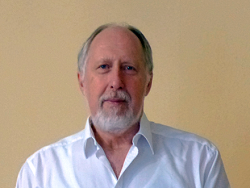- Speaker
- Prof. Peter Deák
- Professor of the University of Bremen, Germany (Retired)
- Abstract
In order to obtain highly accurate results for defects and surfaces, two criteria have to be met by the exchange functional applied in DFT: the gap must be reproduced and the generalized Koopmans' theorem has to be fulfilled. This can be achieved by tuning the parameter(s) of hybrid- or screened exact-exchange functionals. The tuning is necessary to achieve the correct electronic screening of the non-local interactions. Therefore, layered materials and surfaces, with spatially strongly inhomogeneous screening, represent a general problem. I will demonstrate this on the layered materials h-BN and GaSe, and show that no optimal solution exists yet for atomically thin monolayers and, even on slab surfaces, the accuracy will be limited in case of a low dielectric constant. In periodic models of charged defects, a smeared-out counter-charge (jellium) must be applied to avoid divergence of the Coulomb energy. Due to the interactions between the repeated images, this gives rise to a spurious electrostatic potential, affecting both the total energy and the one-electron energies/wavefunctions. Usually, only the total energy is corrected at the end of the self-consistent calculation (by, e.g., the Makov-Payne, or Lany-Zunger, or Freysoldt-Neugebauer-Van de Walle, methods). On surfaces this is sometimes insufficient. I will show cases where, without a self-consistent potential correction (SCPC), artificial states arise. I will also describe the working of the SCPC method in VASP calculations.
- About the Speaker
Prof. Peter Deák is a retired professor of the University of Bremen, and presently part-time Senior Scientific Adviser at the Wigner Research Center for Physics in Budapest, as well as Visiting Associate Professor at CSRC in Beijing. He graduated from Budapest University in 1976. He also holds the "Doctor of the Physical Science" title of the Hungarian Academy of Science. After postdoc positions at SUNY@Albany and at MPI-Stuttgart, he was appointed as full professor at the TU Budapest in 1993. In 2004 he left Hungary and took up position as substitute professor at the U. Paderborn. From 2006 to 2020 he was working at the Bremen Center for Computational Materials Science at the University of Bremen. He was visiting professor at the Université P.&M. Curie in Paris, at the Nelson Mandela University in Port Elisabeth, and at the North-Western Polytechnical University in Xi’an. His research is directed towards solving practically relevant problems of materials science by using atomistic quantum mechanical simulations, in close cooperation with experiments.
- Date&Time
- 2024-10-31 10:00 AM
- Location
- Room: A403 Meeting Room




